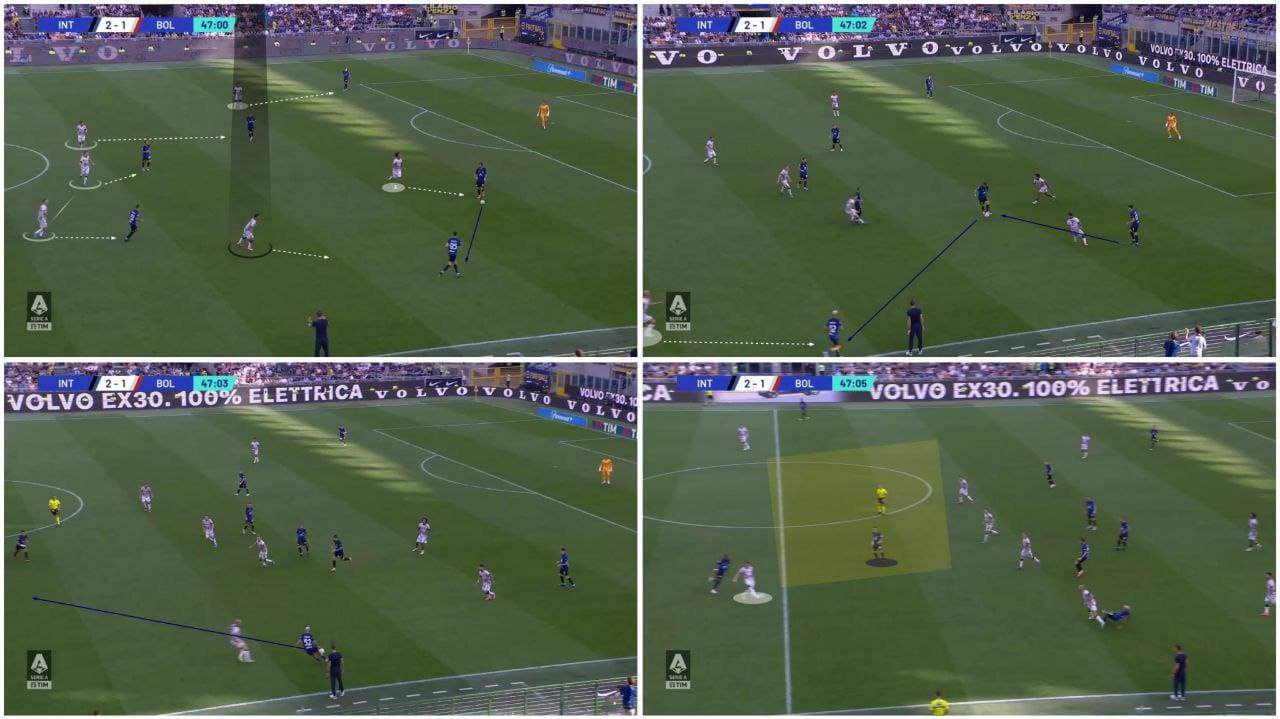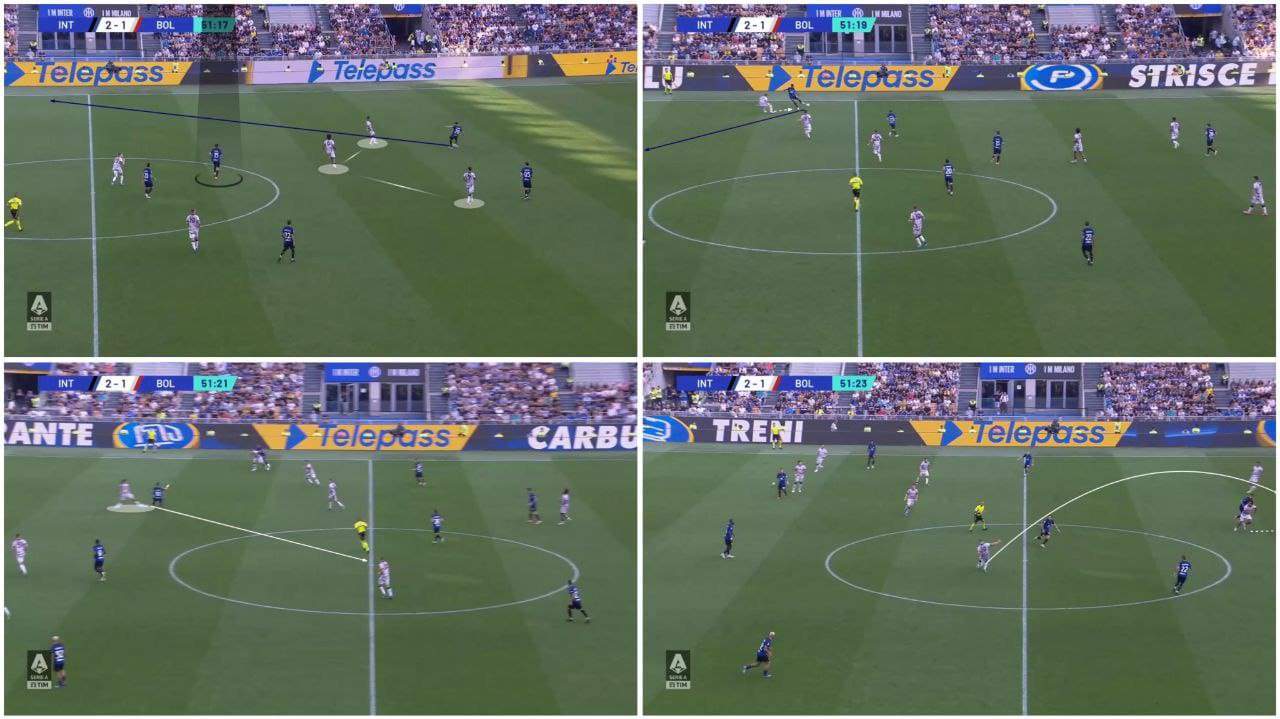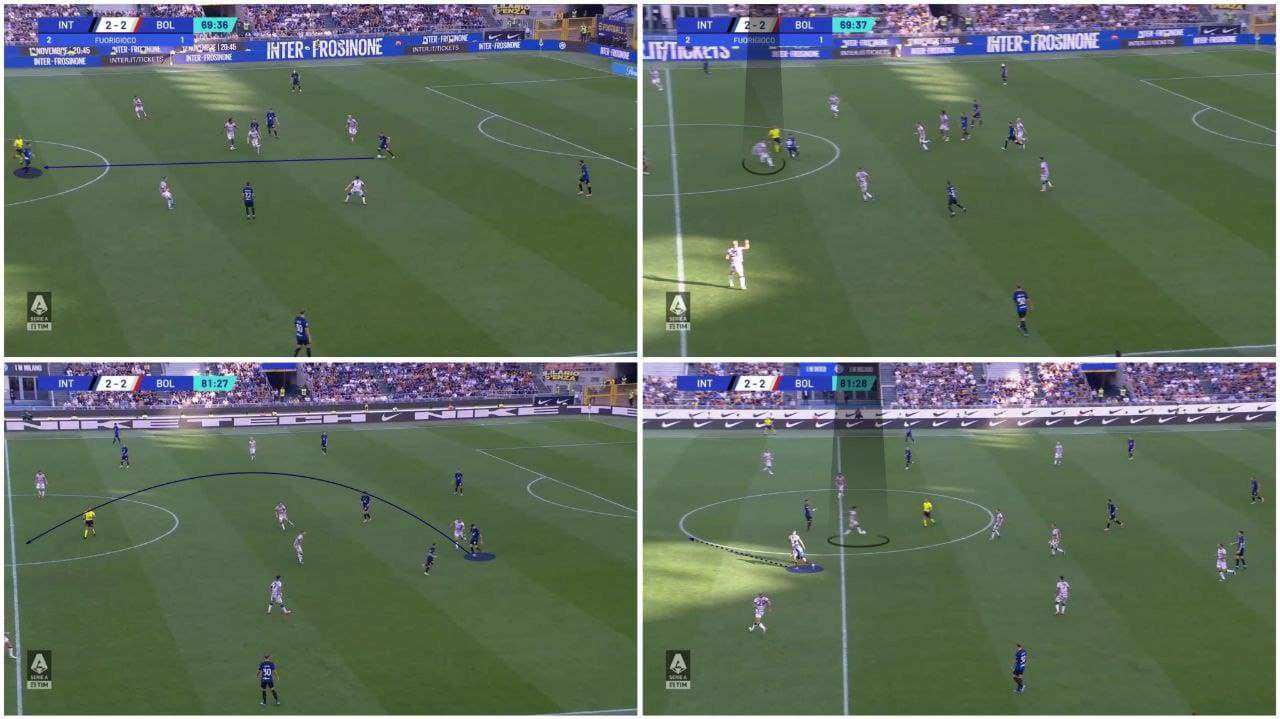With only two points away from the top four after the end of the first half of the season, Bologna’s fifth-place and above top Serie A teams as Roma, Atalanta, Napoli and Lazio, Thiago Motta had announced himself as one of the most promising young managers in the world of football.
The 41-year-old Italian coach developed a performer club that caught the eye this season and made himself a candidate for a possible future move as some rumours suggested that the former Inter Milan midfielder could replace Stefano Pioli at AC Milan.
One of the quality phases he offers with Bologna is their high pressing, how they can suffocate their opponents’ build-up and adapt to the changes during the game and against different clubs.
Our tactical analysis and scout report will provide an analysis of Bologna’s pressing, tactics and ideas out of possession. Let’s start with their game against Lazio.
Bologna vs Lazio
Maurizio Sarri’s Lazio started on a 4-3-3 shape during the build-up, a back four of Manuel Lazzari, Patric, Alessio Romagnoli and Adam Marušić.
Along with Nicolò Rovella as the defensive midfielder, Matteo Guendouzi is closer to him than Luis Alberto, who is in a more advanced position. Simply, their build-up approach relied on finding Alberto in between the lines in which he could attract a centre-back and create gaps in the opposition’s backline.
On the other hand, Thiago Motta’s side relies on a 4-2-3-1 high-pressing shape.
One of Joshua Zirkzee, the forward, and Lewis Ferguson, the central attacking midfielder, is pressing the two centre-backs while the other is marking Lazio’s Rovella. Furthermore, Alexis Saelemaekers and Riccardo Orsolini are marking the full-backs, and lastly, the pivot of Remo Freuler and Michel Aebischer are pressing both Guendouzi and Alberto.
Consequently, Bologna had an extra man in the backline that completely countered Lazio’s ideas during the build-up.

We can see below Ferguson is pressing Romagnoli and, Zirkzee is heading towards Rovella, Romagnoli is trying to find Alberto. Anyway, Bologna is matching Lazio’s midfield three.

Freuler is pressing Alberto immediately, forcing him to return to his goalkeeper.

Later, Patric has the ball and is now pressed by Zirkzee while the right winger Orsolini shifted to press Romagnoli, isolating Lazio’s left-back.
Patric was forced to go long, and his team lost possession.

Once again, Zirkzee is pressing Romagnoli, who is going to receive from Marušić; meanwhile, Ferguson is pressing Rovella.

Zirkzee and Ferguson pressing forced the error and could intercept the ball.

And now Bologna is ready for the attacking transition.

Another time, Alexis Saelemaekers is pressing the right-back Lazzari with the same pressing scheme.

Lazzari passes towards Guendouzi, pressed by Freuler, and Lazio again lost the ball, and Orsolini again shifted towards Romagnoli.

Nevertheless, the away side had a numerical superiority on the first line of the build-up, which gave them more time and space on the ball, so most of the time, Motta’s team was forced to drop for a mid-press.
However, Lazio didn’t succeed in creating goal-scoring chances.
They could only escape I Rossoblù’s press by using the pressing triggers as a decoy; here, Romagnoli’s pass found Alberto and the Spanish returned to his goalkeeper.

Alberto’s pass wasn’t accurate enough, forcing Ivan Provedel to receive almost on the edge of the penalty box, which triggered Zirkzee to press. Still, Provedel was calm enough to pick a precise pass to Rovella.

Rovella could receive away from Ferguson, who was pressing Romagnoli, and now Freuler had to press, leaving Guendouzi to receive freely.

Inter Milan vs Bologna
Moving on to their game against Inter, they could seal a valuable point away from home against the Italian champions and the current league leaders.
Simone Inzaghi’s side had a 3-5-2 build-up shape against a 4-3-3 high-pressing from I Rossoblù.
A back-three of Francesco Acerbi, Benjamin Pavard and Alessandro Bastoni are being pressed by Bologna’s front three Zirkzee, Dan Ndoye and Orsolini.
Thiago Motta’s pressing approaches appear to prefer to match the opposition’s midfield, which consequently means a midfield three of Hakan Çalhanoğlu, Nicolò Barella and Henrikh Mkhitaryan are being matched by tight marking from Michel Aebischer, Freuler and Ferguson.
In addition to the full-backs, Lorenzo De Silvestri and Charalampos Lykogiannis are pressing Inter’s wing-backs Denzel Dumfries and Federico Dimarco.

I Rossoblù intended to close down any central progression on Inzaghi’s defenders, forcing them to only go for their wing-backs.
This occurs via the narrow positioning of the wingers, Orsolini, who is pressing Pastoni and Ndoye against Pavard. With the tight 3v3 in the midfield, the only option left for Inter is through their wide areas.
Here, Dumfries had the ball and was pressed by Lykogiannis (highlighted in red) and the other full-back, De Silvestri, joining the two centre-backs, leaving Dimarco isolated and forming a back-three shape.
That only created a gap behind Bologna’s midfield. Dumfries tried to find Marcus Thuram in that area, but Freuler anticipated the pass.

Again, Dumfries with the ball in the same situation, setting the ball for Mkhitaryan, who is trying to find Barella down the line.

Due to Bologna’s tight pressing, Mkhitaryan’s pass was hard enough for Barella, who is positioned as a right-winger; here, we can get more knowledge about Motta’s flexibility in pressing.
Bologna’s centre-back Riccardo Calafiori was the one pressed Barella shifting with Ferguson, who is shadowed and marking Lautaro Martínez as he is more centrally, closer to Ferguson than Calafiori.
The same back-three line and Dimarco completely isolated on the other side alongside Thuram is free in the gap behind the midfield, but his teammates couldn’t find him.

Ferguson followed Lautaro and intercepted the ball.

We can observe below how Orsolini (highlighted in black) is more centrally positioned; his priority is to close the central passing lane while opening the angle for Bastoni towards Dimarco.

Di Silvestri pressed Dimarco while Ferguson (shadowed) is down the line, this time with Mkhitaryan.

This forced Sam Beukema and Calafiori to drop with Lautaro and Thuram, and again Inter lost the possession.

One of the ideas the home side had was that Acerbi (highlighted in yellow) move forward towards the midfield, which got Ferguson in a 2v1 situation. Anyway, Zirkzee didn’t follow the Italian defender; instead, he maintained his possession.

Pavard returned to his goalkeeper, Yann Sommer, and Zirkzee pressed him, giving him no time on the ball, so he could not utilise the advantage of having a plus on the midfield and was forced to go long.

Below, we can see again the same positioning of Acerbi in which Çalhanoğlu drops in the backline that did not alter the pressing scheme, and everyone maintained his position.
Bastoni has to go for Dimarco again.

Here, Thuram dropped to receive and dragged Beukema with him, creating a gap in the back line, which Bastoni ran into to utilise.

Again, Bologna’s brilliant shifting and organisation switched off any threat out of this situation; Orsolini ( highlighted in yellow ) did not follow Bastoni as if he did, Bastoni would have been ahead of him as well as more time on the ball. Thuram would have.
Instead, he shifted with Di Selvistri ( in red ), who is now responsible for marking Bastoni and Thuram being closed down by Orsolini.

Barella drops here to receive, dragging Freuler with him, and Pavard moves forward towards the evacuated area.

Nonetheless, Freuler and Ndoye did not shift, and Sommer could find Pavard, who could receive as Ndoye was not close enough to him.

And I Nerazzurri escaped the press now.

Their organised shifting between the players during pressing is very impressive, even though there will be moments of disorganisation or switching off for a moment. In contrast, most of the match they succeeded in suffocating Inter’s build-up.
The same continued throughout the second half. Inzaghi’s side was always forced to go wide and then lose the ball.
Orsolini (shadowed) with the same central position, Acerbi passes to Dimarco, whose pass for Thuram was intercepted, and we can notice the massive free area in the centre for Lautaro.

The same thing happened again with Acerbi joining the midfield, but Zirkzee maintained his position; this time, Dumfries tried to pick a breaking line pass for Lautaro, but again, Calafiori intercepted.
Then Ferguson received the ball and played a brilliant pass for Zirkzee, who had the space left by Acerbi to turn into for the transition.

The Dutch forward successfully scored the equaliser.

Additionally, Bologna’s centre-backs had the freedom to drop in that gap created we mentioned before. This opened up a space in their last line that could be utilised, as shown in the previous image, but a risk was taken in that game as most of the balls were anticipated before.

Coppa Italia
The tactical battle between Inzaghi and Motta continued with their meeting in round 16 of Coppa Italia, where I Rossoblù booked their place for the next round by beating Inter 2-1 after the extra time at San Siro Stadium.
Firstly, How do the current domestic cup champions try to overcome Bologna’s pressing?
The game started with the same shapes from both teams. Although, the home side attempted to solve the problem through their midfield movement.

Acerbi had the exact same position in the midfield most of the time, and Sydney van Hooijdonk, who started instead of Zirkzee, tightly marked him.
As we discussed, it’s not the same as the young Dutch striker who maintained his position and pressed the goalkeeper.

This allowed Inter’s goalkeeper Emil Audero more time on the ball to pick a breaking line pass towards Lautaro.
Meanwhile, Davide Frattesi (shadowed) ran forward right away to give his Argentinian striker more space in the midfield by dragging his marker and utilising the space left by Beukema, who stepped to press Martínez.

Once again, Hooijdonk is staying with Acerbi, who is forming a box-midfield.

Audero, having more time on the ball, plays to Matteo Darmian. Additionally, the two midfielders Kristjan Asllani and Frattesi are dropping deep to free up the space centrally.

Asllani plays a one-touch pass aiming for Lautaro. We can notice the red-highlighted player Hooijdonk’s different position compared to Zirkzee in the game before.

Lautaro smartly flicks the ball while Frattesi and Yann Aurel Bisseck, the left centre-back, run at full speed, trying to make the best use of the open area at the opposition’s midfield has been dragged successfully.

A dangerous attack situation occurred.

Therefore, Inter Milan had two main ideas to encounter the pressing. Firstly, more dropping and deeper positioning of at least one of their midfielders aided by Acerbi’s advanced position.
Secondly, through the sharp forward movement from the advanced midfielders, as we mentioned with Fratessi when the ball is played to Lautaro, providing him more space and utilising the space left by the opposition’s defender, who had to step and press Martínez in the free space behind Bologna’s midfield we mentioned at the League game.
Hooijdonk’s rule to stay with Acerbi also helped by giving the keeper more time on the ball; when Zirkzee stepped to press Sommer, he forced him to lose the possession through the long balls.
Consequently, Motta shifted his pressing frontline into two of Alexis Saelemaekers and Hooijdonk against Inter’s back-three as well as the left winger Kacper Urbański (highlighted in red) is now marking Darmian instead of Bisseck.

Along with the right-back, Tommaso Corazza has the same role of pressing the left-wing back Carlos Augusto, which gave the 4-4-2 shape of pressing.
With more numerical superiority on the first line, the away side returned to a more mid-press.
Bastoni plays a direct pass towards Marko Arnautović behind the second line of pressing.

The Austrian received but with less space now between Bologna’s lines; also, Aebischer (highlighted in red) is dropping almost as a centre-back to stay with Frattesi.

The same front two and Urbański now is more on the second line.

Aebischer (shadowed) is behind Bologna’s midfield of four and close to Frattesi.

The ball reached Lautaro in the gap, but now the presence of Aebischer compensated that empty area.

Conclusion
Thiago Motta’s Bologna is having a magnificent season thanks to their brilliant, diverse pressing and adaptability to the different situations against each team.
Not to mention the fact that they are quite impressive during the other game’s offensive and defensive phases that got them under the radar for the rest of the upcoming season now.





Comments